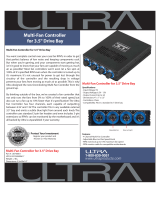
33
33
3
ContentsContents
ContentsContents
Contents
1.1.
1.1.
1.
IntroductionIntroduction
IntroductionIntroduction
Introduction
........................................................................................................................
........................................................................................................................
............................................................
5 5
5 5
5
1.1 Package Contents..................................................................... 5
1.2 Specifications ........................................................................... 6
1.3 Motherboard Layout ................................................................. 9
1.4 HD 8CH I/O ................................................................................ 10
2.2.
2.2.
2.
InstallationInstallation
InstallationInstallation
Installation
............................................................................................................................
............................................................................................................................
..............................................................
11 11
11 11
11
Pre-installation Precautions ............................................................... 11
2.1 CPU Installation ......................................................................... 12
2.2 Installation of CPU Fan and Heatsink ....................................... 12
2.3 Installation of Memory Modules (DIMM).................................... 13
2.4 Expansion Slots (PCI, PCI Express, and HDMR Slots) .................... 14
2.5 Easy Multi Monitor Feature........................................................ 14
2.6 Jumpers Setup.......................................................................... 15
2.7 Onboard Headers and Connectors.......................................... 15
2.8 SATAII Hard Disk Setup Guide .................................................. 20
2.9 Serial ATA (SATA) / Serial ATAII (SATAII) Hard Disks
Installation ................................................................................. 21
2.10 Installing Windows 2000 / XP / XP 64-bit Without RAID
Functions ................................................................................. 22
2.11 Installing Windows 2000 / XP / XP 64-bit With RAID Functions. 22
2.12 Untied Overclocking Technology .............................................. 22
3.3.
3.3.
3.
BIOS SBIOS S
BIOS SBIOS S
BIOS S
ETUP UTILITYETUP UTILITY
ETUP UTILITYETUP UTILITY
ETUP UTILITY
......................................................................................................
......................................................................................................
...................................................
23 23
23 23
23
3.1 Introduction ............................................................................... 23
3.1.1 BIOS Menu Bar ............................................................... 23
3.1.2 Navigation Keys ............................................................. 24
3.2 Main Screen.............................................................................. 24
3.3 Advanced Screen .................................................................... 25
3.3.1 CPU Configuration .......................................................... 25
3.3.2 Chipset Configuration..................................................... 28
3.3.3 ACPI Configuration ......................................................... 29
3.3.4 IDE Configuration ............................................................ 30
3.3.5 PCIPnP Configuration ...................................................... 32
3.3.6 Floppy Configuration ...................................................... 33
3.3.7 Super IO Configuration................................................... 33
3.3.8 USB Configuration.......................................................... 35
3.4 Hardware Health Event Monitoring Screen ............................. 35
3.5 Boot Screen.............................................................................. 36
3.5.1 Boot Settings Configuration ........................................... 36
3.6 Security Screen........................................................................ 37
3.7 Exit Screen ............................................................................... 38






















